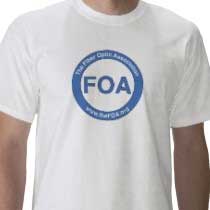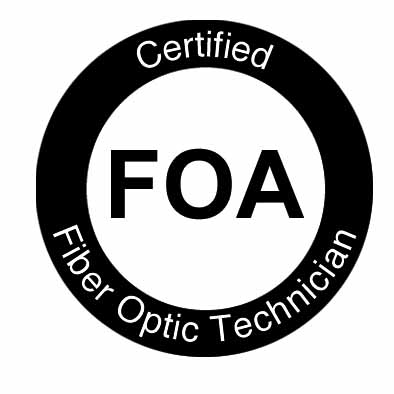What Needs To Be In A Contract - And Why It's Important
FOA regularly gets phone calls or emails about disagreements or disputes between network owners and installers regarding what should have been done in a project. Most of the time, the issue is the difference between what was expected of the contractor by the network owner and what was delivered. The problem is usually that the network owner did not put in the contract what they thought they did and the contractor did only what was in the contract. The other issue we see is a lack of understanding of what is implied (and required) by "industry standards."
A contract is a legal document, in this case between network owner and contractor, which may be written by either party but signed by both that spells our exactly what work is to be performed. The contract needs to be precisely worded because it may eventually be read in court if a dispute arises. If something is written in the contract, it should be done. If it's not in the contract, the contractor is not legally required to do that work.
The most common disagreement is over testing. Does installing a cable include testing it? (Probably not) Does installing a cable to industry standards include testing it? (Maybe not)
How about a contractor that installs counterfeit cables? If the contract calls for "Cat 5e" cables, dos that mean counterfeit cable does not meet the contract? (Probably so)
We recommend you read the FOA page on project "paperwork." Note all the issues we bring up under the "Scope of Work" (SOW) or what some call the "Statement of Work." And never forget that every contract should include what is expected for documentation.
More From Alabama - Google To Open Data Center In Former Coal-Fired Power Plant

Google has 14 data centers around the world (map here) with the latest planned for an unusual location - the building of Widows Creek, a former coal-fired power plant in Jackson County, Alabama. To add to the irony, Google announced it would work with TVA, the SE regional power authority and current owner of the plant, to bring online more alternative power for the data center.
In an article in the NY Times, it was reported "While there is considerable irony in taking over a coal-burning plant and promoting alternative power, there are pragmatic reasons Google would want to put this data center, its seventh in the United States, in such a facility. These are typically large and solid structures, clearly with good power lines, but also access to lots of water, which Google uses for cooling its computers. The Alabama plant is next to a reservoir on the Tennessee River. There are also rail lines into the facility, which makes it likely Google can access buried conduits along the tracks to run fiber-optic cable."
According to the Google Data Centers web page, the data center will provide jobs for 75-100 people in a variety of technical and support positions.
Why the US Agriculture Department is giving out tens of millions of dollars for Internet access
You've probably never heard of La Valle. It's a town of about 1,300 people in southwest Wisconsin that's a two-hour drive from Milwaukee. But it may as well be on the other side of the world when it comes to phone and Internet access. La Valle, like many rural communities in America, have been passed over by the country's major communications providers, leaving the small town to fend for itself. And it has done so tremendously: Residents can buy fiber-optic Internet from the customer-owned LaValle Telephone Cooperative at speeds of up to 60 megabits per second — fast enough to rival the connections many Americans enjoy elsewhere.
"Being in a rural area, we've got hills, rocks," said Greg Rockweiler, an office manager and a 26-year veteran of the company. "Building fiber is difficult at times." That's why this week the co-op will be getting a $7.61 million loan from the federal government. It's part of a package announced Monday that will deliver $85 million in new funding nationwide for rural Internet access, and La Valle is one of eight providers to be receiving a loan or grant.
Read more in the Washington Post.
Antarctic Probe Searches Under Ice Shelf, Helps Prepare For NASA Space Missions
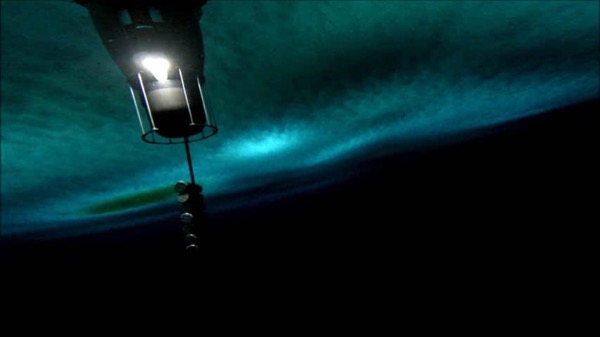
In the summer of 2014 a team of scientists from the Georgia Institute of Technology headed to Antarctica to deploy Icefin - a 10-foot long, 12-inch diameter, 220 pound, first of its kind ROV - deep beneath the ice shelf. This mission, funded by NASA and supported by the National Science Foundation, was intended to prepare for potential future missions on Jupiter’s moon, Europa. Europa has an outer ice shell, a rocky interior and a subsurface ocean in between. The best chance for life to exist in our solar system may be there in this remote ocean encapsulated by ice.
This research may someday help us learn about life on other planets, but even today it is helping us learn about life in remote places here on Earth. What is unique about this vehicle is that it is “a hybrid between the really small probes and the ocean-going vessels, and we can deploy it through bore holes on Antarctica,” said Britney Schmidt, an assistant professor in the School of Earth and Atmospheric Sciences at Georgia Tech, and the principle investigator for the Icefin project.
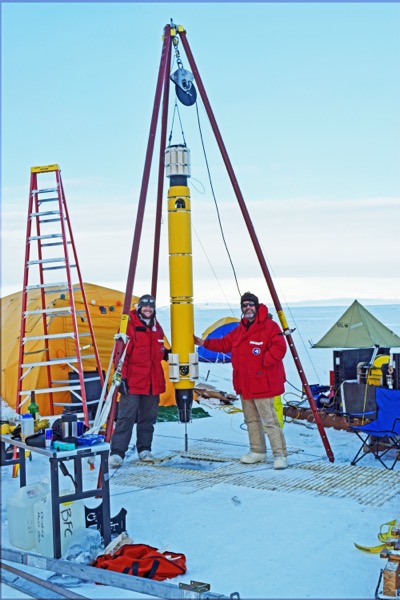
“What truly separates Icefin from some of the other vehicles is that it’s fairly slender, yet still has all of the sensors that the scientists like Britney need,” Principal Research Engineer Mick West said. “Our vehicle has instrumentation aboard both for navigation and ocean science that other vehicles do not.” Most vehicles that have explored this area are either small vehicles with a camera only, or very large vehicles that cannot be launched from a bore hole. Icefin fills the gap between these two kinds of vehicles: able to be deployed easily by small teams in any environment, yet still able to record oceanographic information traditionally done by much larger vehicles.
To tether this vehicle to the surface the team relied on a Linden Photonics 3.5 mm STFOC tether. Linden’s STFOC tether is used for communication, data retrieval, and emergency recovery purposes. The team had to design for a number of challenges associated with deploying Icefin in such an extreme environment. For example, standard electronics systems are not typically rated to the extreme temperatures found under the Ross Ice Shelf.

The Southern Ocean can be as deep as 5,000 meters. Icefin is capable of diving 1,500 meters and can perform three-kilometer-long surveys. Previous vehicles in Icefin’s class were rated to a few hundred meters.
Icefin is planned to make its Arctic debut in summer 2016, with a return to Antarctica that fall. And maybe one day 356 million miles away on a moon of Jupiter.
View videos from the mission:
https://www.youtube.com/watch?v=yqtxDb5VUZ4
https://www.youtube.com/watch?v=RHwLMfYfUh8
What Is The Procedure For Construction Of An OSP Fiber Network?
We recently received an inquiry which we passed along to Joe Botha, author of the new FOA OSP Fiber Optics Civil Works Guide. His answer was a list that provides a simple checklist for OSP construction, so we thought we'd pass it along to everyone.
To answer the question “Please summarize the construction procedure for ODN network” - I have responded as shown below:
1. Perform a pre-build survey.
2. Obtain Wayleave (easement) agreements.
3. Prepare a Project Management Plan.
4. Prepare a site-specific Environmental Management Plan.
5. Prepare a site-specific Safety Plan.
6. Prepare a Quality Monitoring and Controlling Plan.
7. Businesses / property owner notifications.
8. Trench, lay ducts, close trench, install MHs and perform reinstatements.
9. Perform DCP Testing.
10. Pre-test cables with an OTDR.
11. Perform DIT testing.
12. Blow or haul cables.
13. Fusion splice cables.
14. Acceptance testing i.e. IL, OTDR, etc.
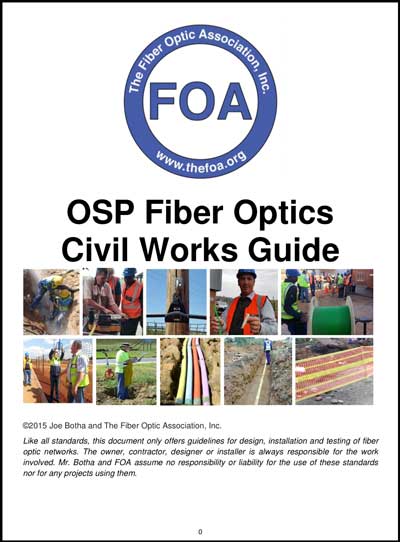
You can download a free copy of the FOA OSP Fiber Optics Civil Works Guide by Joe Botha here.
More Gigabit Fiber News
Bell Canada "Gigabit Fibe" bringing the fastest Internet to Toronto residents with a billion-dollar+ network investment, creation of 2,400 direct jobs.
- Gigabit Fibe to be rolled out to 1.1 million Toronto homes and businesses; 50,000 premises will have access this summer
- Bell investing $1.14 billion in Canada's biggest gigabit infrastructure project
- Close cooperation with Toronto Hydro increases project speed and efficiency
- Bell contributing Gigabit Fibe service to United Way Toronto's Community Hubs initiative
- Other cities getting Gigabit Fibe service as soon as this summer; fibre infrastructure expansion ongoing in Ontario, Québec and Atlantic Canada
- (read more)
Google Fiber uses Bechtel to deploy fiber in Atlanta, Charlotte and Raleigh-Durham (more)
- In Atlanta, Google plans to deploy 3,400 miles of fiber that will be attached to more than 100,000 utility poles. This fiber will also be deployed to 23 huts where the company will house the electronics that serve the customers.
- Charlotte will have a similar configuration, except that 3,200 miles of fiber will be attached to more than 50,000 utility poles, with the electronics being housed in 19 huts.
- In Raleigh-Durham, the company's fiber deployment will involve 5,600 miles of fiber, 50,000 utility poles and 26 huts.
Here is where to keep track of what is happening with Google Fiber - the Google Fiber Facebook page!
Best Quotes From FTTH Council Conference
"FCC supports communities taking control of their broadband future." Gigi Sohn, Counselor to the Chairman, FCC
"We're not doing this as a hobby anymore." Eric Schmidt, quoted during an interview with Michael Slinger, Google Fiber.
"The minute we announce a city. speed goes up and prices go down." Michael Slinger, Google Fiber.
"Buildings need to be designed for fiber." Jeremy Ferkin, Centurylink
Best Product From FTTH Council Conference
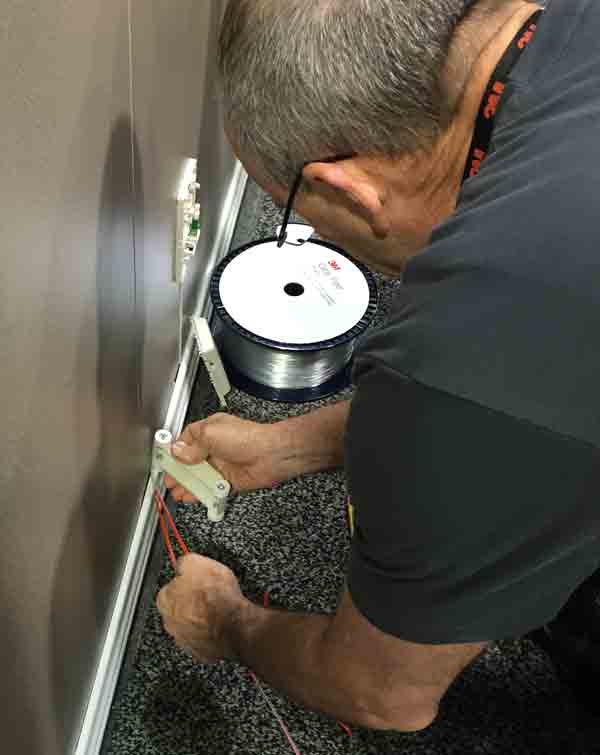 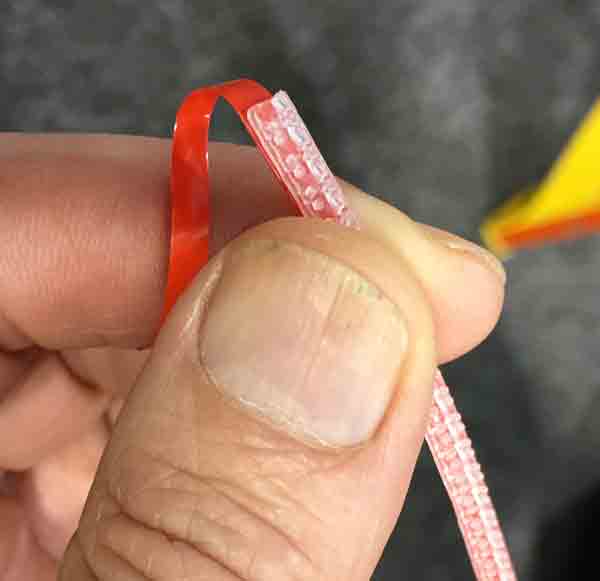
3M showed Clear Track Fiber Pathway, an ingenious, almost invisible solution to running fiber for indoor residential or office applications. Clear Track is a small flexible track designed to hold a single 900micron 3M Clear Fiber. It can be run along baseboard or molding and is really small and virtually invisible. 3M Clear Fiber is a bend insensitive fiber so it can be easily bent around corners without harming the fiber's transmission performance. The Clear Track Fiber Pathway has a 3M adhesive (of course, they invented Scotch Tape!) that peels off easily to allow sticking to a wall. They even have a special tool that rolls along the Pathway and inserts the fiber. Clever!
They also showed 3M Clear Fiber Drop Cable, a tiny indoor/outdoor drop cable with a single 900micron bend insensitive fiber and two parallel fiber reinforced polymer strength members in a jacketed cable only 2.5mm by 4mm.
Another Myth? Sharks are not the Nemesis of Submarine Cables
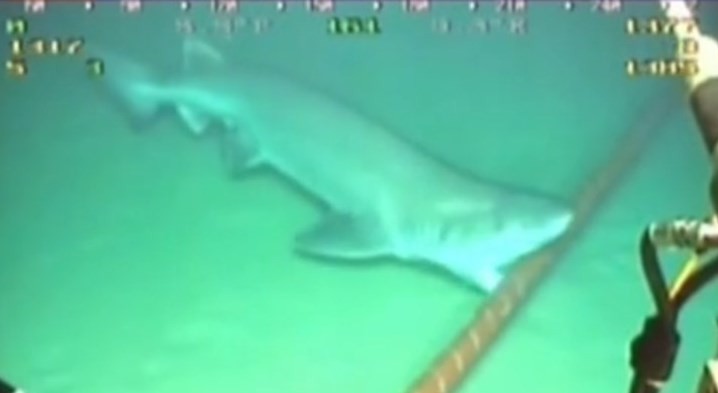
In August 2014, a rediscovered YouTube video of a shark biting a subsea cable caused a media storm. According to some commentators, the video signified that worldwide telecommunications were under attack by sharks because submarine fibre-optic cables are the backbone of the global Internet. The International Cable Protection Committee (ICPC) has reviewed records of cable faults worldwide, and together with an assessment of the video, conclude that much of the media hype was incorrect. Essentially, sharks and other fish were responsible for less than 1% of all cable faults up to 2006. Since then, no such cable faults have been recorded.
Read the ICPC report.
More On MPO Fiber Polarity
As we always point out, MPO array connector polarity is complicated - so complicated it currently takes 23 pages in TIA-568 and that may get even larger in the next revision of the standard. We've covered the issues of pins/no pins and keyup/keydown polarity before, but there is still another layer of polarity detail - at the fiber level.
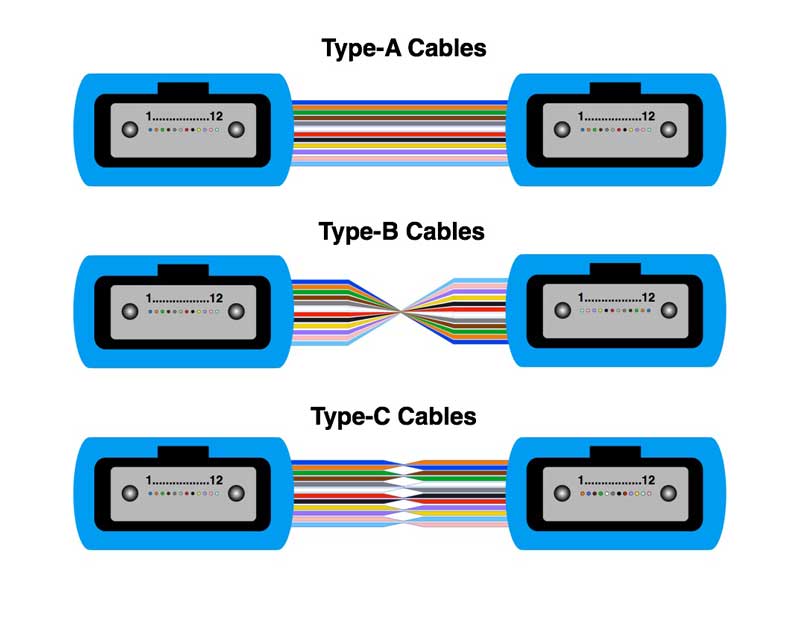
In fact there are three types of MPO to MPO type cables. Type A cables are straight through cables, what you might expect with a multifiber connector, where the fiber that starts on position #1 on one of the connectors ends up on the same #1 position on the other connector. That's what you might expect if you think about fiber polarity where the same color-coded fiber remains in the same position.
But with MPOs, there is a Type B cable where all the fibers are reversed. In a Type B cable, the fibers are reversed. This is accomplished by reversing the fiber orders in the connectors so fiber #1 goes in connector hole #12, #2 foes in hole #11 to #12 fiber in #1 hole. This is a cable you would use it you have a 40G parallel optics link and use a single cable to connect the transceivers (see diagram on the parallel optics for 40G above since you must reverse conductors at some point. There are other ways to do the reversal, e.g. with a mating adapter if you have several cables in the cable plant.
Then there is a Type C cable. Type C cables have the fibers divided into 6 pairs which are reversed in the cable. That is the blue fiber in position #1 moves to position #2 and the orange fiber in position #2 moves to position #1 and so on. Type C are intended to be used with prefab cabling systems which will connect to breakouts (cables or modules) individual 2-fiber channels on each end as shown above. Reversing the pairs means that regular duplex patchcords will have a crossover needed to allow transmitters to connect to receivers and vice versa. Needless to say, this cable could prove to be a big problem if you tried to use this as a cable for 40G links, as the reversed pairs will need to be reversed a second time with another of these cables. It seems better to not use this cable but put the crossovers into modules on each end that break out the MPO connection to duplex connectors.
Next there are two types of MPO > MPO mating adapters. Type A mates the two connectors keyup to keydown so two Type A cables will allow the color codes to remain correct. The Type B adapter mates two MPO connectors keyup to keyup, reversing the fibers like the Type B cables.
Looking at all these options and adding the options for breakouts on each end, you can see how it's easy to fill 23 pages with diagrams. We've tried to simplify it on an expanded MPO page on the FOA Guide which we recommend you read.
There is a new YouTube video on this part of the MPO polarity -FOA Lecture 44 MPO Connector Fiber Polarity- see below.

New FOA YouTube Videos - Focus On MPO Connectors - Prefab Cabling With MPOs, Testing MPOs and MPO Polarity
We continue to get inquiries about MPO connectors, especially testing them. A continual concern is the variability of loss when testing them. It seems they are not all that repeatable, making testing confusing. We've tried to create materials that explain them and their use. We've recently added three more videos - all focused on the MPO array connector - to the FOA YouTube channel.
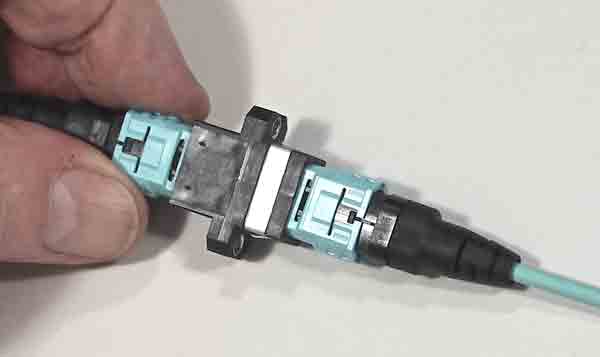
The Panduit PanMPO Connector
FOA Lecture 41 Prefabricated (Preterminated) Fiber Optic Cabling Systems
Prefabricated or preterminated fiber optic cabling systems are made in a factory and installed with no need for termination or splicing. This video looks at how they are used, what components typically are used in manufacturing them and then how to design, install and use a prefab cabling system.
FOA Lecture 42 MPO (Multifiber, Array) Connectors and How To Test Them
MPO fiber optic connectors are multifiber array connectors that have from 12 to 72 fibers in a single connector. These connectors are typically used in prefab (preterminated) fiber optic cabling systems or parallel optics links. They have some unique characteristics in their design and use that users need to understand to implement them successfully. This video will look at their unique features and discuss how to use and test them in actual cable systems.
FOA Lecture 43 Managing Polarity of MPO Connectors (using the PanMPO Connector)
MPO connectors are complicated to manage because they have gender (male/female or as it is generally called "pin/no pin" versions) and keying (generally called "key up/key down"). This creates problems having the right patchcords to test or connect them in systems. In this video, we show the variations and how to accommodate them all with one connector - the Panduit PanMPO. (Thanks to Robert Reid and Panduit for samples to use in the video.)
FOA Lecture 44 MPO Connector Fiber Polarity
Besides the pins/no pins and key up/key down polarity issues, there is the issue of how fibers are arranged in the various types of MPO cables and mating adapters. This video will explain the types of cables and mating adapters and show how the fibers are arranged in each of these components.
Safety On The Job
 
Safety is the most important part of any job. Installers need to understand the safety issues to be safe. An excellent guide to analyzing job hazards is from OSHA, the US Occupational Safety and Health Administration. Here is a link to their guide for job hazard analysis.
FOA also has lots of information on safety: FOA Guide, YouTube video and a Safety Poster
"Worth Reading" Is Now On
Join FOA on Pinterest. We have been posting links to pages "Worth Reading" on a special FOA Pinterest page. You can join and keep up to date with the news on our industry which we put there.
Recent posts cover utilities using new generation telecom, India's plan for 100 smart cities, Cincinnati Bell bets on fiber, various opinions on the US battle over net neutrality, etc.
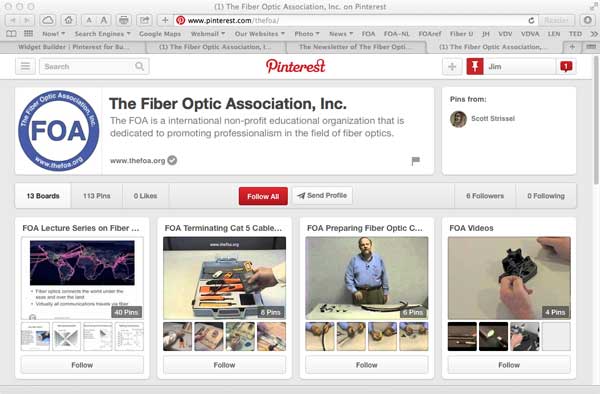
Clean Every Connector - A Lesson We Learned From Creating Lessons
In creating the fiber characterization curriculum, we got inputs from many experienced techs about the testing requirements. Everyone we talked to made a big point about cleaning and inspecting connectors before testing. Dirty connectors are a major problem with errors in testing. We've also seen that many installers think that if a connector, especially new connectors, has a "dust cap" on the connector, it does not need cleaning. WRONG!
The common name for the plastic caps on connector ferrules is "dust cap" and a friend says they are called "dust caps" because they are full of dust. Those plastic caps are made by the millions, popped out of plastic molding machines into barrels and stored until put into plastic bags. Whenever you remove one of them, clean the connector before testing or connecting it.
More on connector cleaning is here and here.
What You Need To Know About Fiber Optic Cleaning And More
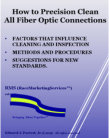 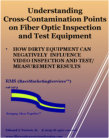 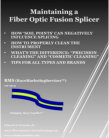 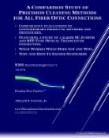
Ed Forrest, one of the industry experts on cleaning fiber optic connectors, retired about a year ago. We encouraged him to put down on paper what he knew about fiber cleaning and he took our advice. He's now created 4 books on cleaning topics that cover just about everything you need to know. And he added another volume that's also important - maintaining fusion splicers. We recommend these books highly.
How to Precision Clean All Fiber Optic Connections
Understanding Cross-Contamination Points on Fiber Optic Inspection & Test Equipment
Maintaining a Fiber Optic Fusion Splicer
Comparison Study of Precision Cleaning Methods for All Fiber Optic Connection
Whitepaper: The Significance to Optical Internconnect: Properly Cleaning a Fiber Optic Connection
Information on Ed's books is at http://fiberopticprecisioncleaning.com/available-books-whitepapers/.
Good Practice Tools For OTDRs, All Free
FOA OTDR Simulator
You may already know that the FOA has a free OTDR Simulator you can download from our website (go here for directions) that allows you to practice using an OTDR on your PC, seeing the effects of changing setup parameters and analyzing dozens of real world traces. But here are two more tools that can be good for practice.
OTDR FAQs
Including more hints from FOA Master Instructor Terry O'Malley like tests on what the end of a fiber trace looks like with broken and cleaved fibers.
Frequently Asked Questions On OTDRS And Hints On Their Use
"Fiberizer" APP Reads, Analyzes OTDR Traces
Fiberizer is a iPhone/iPad APP that reads industry-standard ".sor" format files and allows trace analysis on your iPhone or iPad. An android version is in the works too. Read more about Fiberizer. And here are more directions on its use.
Events of Interest
Don't Miss These Seminars and Webinars:

Fiber Testing - Presented By Jim Hayes, FOA
This event will be held April 9, 2015
1:00 PM EDT / 12:00 PM CDT / 10:00 AM PDT / 5:00 PM GMT
This webcast seminar, presented by Jim Hayes, examines several ways in which fiber testing- both insertion loss and OTDR testing - has evolved. The seminar will begin with a basic tutorial of fiber-transmission principles and test fundamentals. It will then discuss the uncertainties of each fiber-optic measurement method. The seminar will then address some of the developments that have served to improve the certainty of test results, as well as how technicians can use their instruments more effectively to reduce measurement errors.
Sign Up Here
~~~~~~~~~~~~~~~~~~

Trends in Fiber Testing & Certification
Presented by Ed Gastle, JDSU
Make sure you're up to date on the current trends and practices for fiber testing and certification.
Now available on demand.
TIA FOTC offers regular webinars and archives them here so you can watch anytime.
~~~~~~~~~~~~~~~~~~~
 New local programs for fiber installation training New local programs for fiber installation training
See the Light® Fiber Optic Training Program
Webinars, seminars and certification training classes.
Corning offers a library of more than 200 videos that help our customers with everything from product preparation and installation to proper testing procedures. Our free Video Library Tool provides direct links to individual Corning videos, and allows you to filter by topic or area of interest. Register to download the Video Library Tool.
~~~~~~~~~~~~~~~~~~
RETURN TO INDEX
 What's Happening @ FOA What's Happening @ FOA

FOA has three LinkedIn Groups
FOA - covers FOA, technology and jobs in the fiber optic marketplace
FOA Fiber Optic Training - open to all, covers fiber optic technology and training topics
FOA School Instructors - a closed group for instructors and administrators at FOA-approved schools
Grupo de La Asociación de Fibra Óptica FOA (Español)
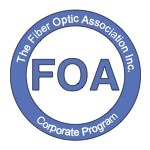 Corporate Memberships Corporate Memberships
FOA is now offering memberships to companies involved in fiber optics as manufacturers, contractors, installers, etc. and government organizations also. Corporate Membership gives companies discounts on memberships and direct certifications and access to special FOA materials for educating customers and employees.
Corporate members are also listed on the FOA website in map and list form.
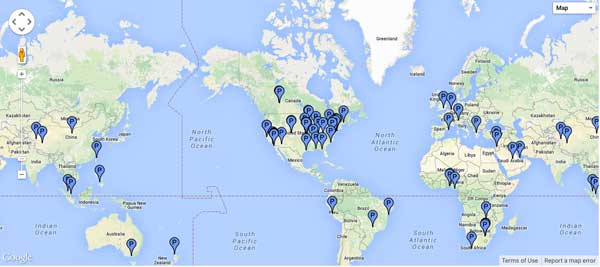
Read more.
FOA Standards:
FOA now offers free standards for datalinks and testing the installed fiber optic cable plant, patchcords and cable, optical power from transmitters or at receivers and OTDR testing.
What Is A Fiber Optic Cable Plant?
In a recent standards meeting, that issue was discussed with some disagreement as to what constituted a "cable plant." It seemed to be a perfect topic for another FOA "1Page Standard," so a draft version is now uploaded for review (FOA Standard FOA-6, Fiber Optic Cable Plant). Feel free to review it and comment to the FOA at info@thefoa.org.
Available also is a new standard for Datalinks.
Look for the "1 PageStandard" web page and in the FOA Online Reference Guide.
Go to the FOA "1 Page Standards"
NECA/FOA 301 Fiber Optic Installation Standard
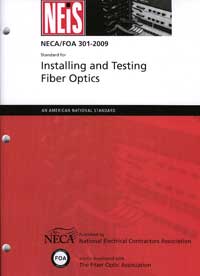
Standards cover components and systems and how to test them, but rarely get into installation issues. The FOA NECA 301 standard which covers installation of optical fiber systems has been revised for the second time, adding considerable new materials. This standard is derived from FOA educational material put in standards form and approved by ANSI as an American National Standard. It's specifically written to be used in contracts to define "installation in a neat and workmanlike manner." The standard is available from NECA. FOA members can go here for instructions on how to download your free copy.
New FOA OSP Construction Guide

FOA has some of the world's experts in fiber optic installation as our certified instructors and it is they who contribute much of the FOA technical materials. Master Instructor Joe Botha of Triple Play Fibre Optic Solutions in South Africa has been one of those contributors. Joe has created a training manual for a new course he is teaching on what they call "Civil Works" and we would call construction.
Joe's course is a prelude to the FOA Outside Plant Fiber Optics Course. Before you splice, terminate and test fibers, you must install cables. Before you install cables, you must place poles for aerial construction or dig trenches for underground construction. While that may sound simple and easy, it is no such thing!
The OSP Fiber Optics Civil Works Guide covers the topics that everyone needs to know - whether you are a network owner/user, contractor, designer, installer (cable layer, splicer, tester, etc.) It covers issues like environmental concerns, safety, easements, and more practical topics like how to dig and back fill trenches.
Joe has created a training manual for his "civils" course that he wants the FOA to share with everyone. This 48 page manual covers just about every topic in fiber optic cable plant construction, including a few that you may never have seen in a manual before. This is a very important document for everyone involved in OSP construction to have.
You can download a free copy of the FOA OSP Fiber Optics Civil Works Guide here.
Application of Standard Project Management Processes in Fiber Optic Cable Plant Project Management
By Alfred Sankara, PMP, CFOS/D – Telecommunications Project Manager
Organizations in the communication industry are proving that adopting proven project management practices reduces risks, cuts costs, and improves success rates of projects. The present article demonstrates how standard project management processes apply to fiber optic cable plant project management.
The article compares the Project Management Institute (PMI)’s standards and guidelines to the FOA’s best practices in terms of fiber optic cable plant project management. PMI is the world's leading not-for-profit professional association for the project, program, and portfolio management profession. PMI strives to mature the profession of project management through standards, certifications, resources, tools, academic research, publications, professional development courses, and networking opportunities.
The PMI’s Guide to the Project Management Body of Knowledge (PMBOK ® Guide) defines the project lifecycle as a combination of the following three (3) main phases: Project Initiation, Project Execution, and Project Closing. This article shows that the FOA’s fiber optic cable plant project management lifecycle phases, which include the Design, Installation, and Testing, fit with PMI’s recommended project lifecycle.
Alfred Sankara is a telecommunications specialist who has been active in the planning, deployment, and operations of telecommunications infrastructure since 1999.In the United States and Africa, Alfred has been involved in the execution of various telecommunications projects, including plans and specifications development, fiber optic network deployment (FTTH, SONET, DWDM, Carrier Ethernet, and OTN) and wireless network implementation (WiMAX, Wi-Fi, UMTS, and LTE).Alfred co-founded DigiBridge TelCo to contribute to reduce the digital divide in emerging countries by assisting governmental entities to deploy state-of-the-art telecommunications infrastructure.
Download a copy of Alfred's article on project management for fiber optic construction.
RETURN TO INDEX
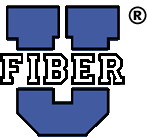
Free Fiber U Self-Study Programs
FOA's "Fiber U" free online self-study programs help you learn about fiber optics, study for FOA certifications or use them to help create "blended learning" classes. There are two new free online self-study programs on Fiber U. Fiber Optic Network Design is for those interested in learning more about how to design fiber optic networks or studying for the CFOS/D certification. FTTx is for those wanting to know more about fiber to the "x" - curb, home, wireless, etc. - or studying for the CFOS/H certification.
Got to Fiber U for more information.
Fiber U Online Self-Study Programs Offer Option Of Certificate of Completion
FOA has been offering quite a few free online self-study programs on Fiber U, our online learning site. We are always getting questions about getting a certificate for completing the course online, so we have setup an option to take a test online and get a certificate of completion for these online courses.
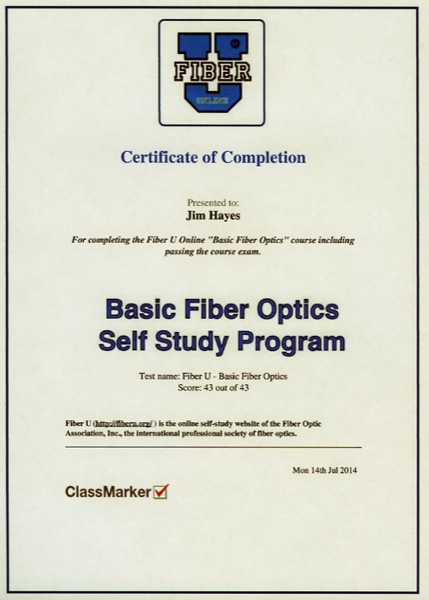
While it's not FOA certification, FOA will recognize a Fiber U Certificate of Completion as background experience to qualify for applying for FOA certifications. We also intend to expand the program to more specialized topics as preparation for FOA specialist certifications.
If you have associates that want to get started in fiber, have them take this course online to get started. Go to Fiber U and get started.
Lennie & Uncle Ted Now Available As Free Books on iTunes
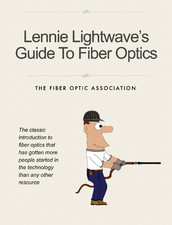 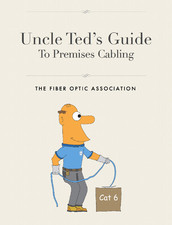
Lennie Lightwave's Guide to Fiber Optics and Uncle Ted's Guide To Premises Cabling are now available free to iPad users who can download them from the Apple iTunes store.
Lennie's Guide has always been the world's favorite introduction to fiber optics. It was first published in the mid-1990s by Fotec, the fiber optic test equipment company famous for its "Fiber U" training conferences and more than 60,000 printed copies were distributed. Lennie was one of the earliest commercial webpages and is still online today (and as popular as ever) at http://lennielightwave.com. Uncle Ted's Guide was created at the request of Lennie readers who wanted a similar simple introduction to "Cat 5" wiring. This latest version of Uncle Ted's Guide covers the all premises cabling topics - wiring, fiber and wireless.
You can find these free guides on Apple's iTunes Store: Lennie Lightwave's Guide to Fiber Optics and Uncle Ted's Guide To Premises Cabling
FOA Textbook Now Available in French / FOA manuel disponible en français
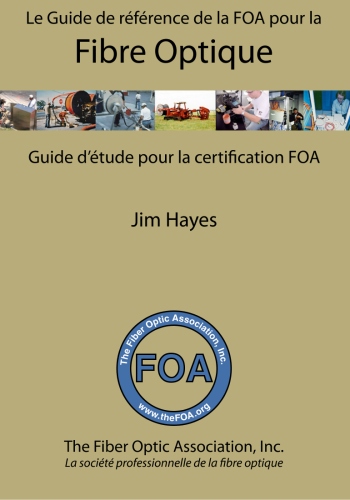
Available from Amazon.com / Disponible sur Amazon.com
And from Createspace / Et à partir de Createspace
FOA Now Offers Fiber Optic Textbook In Spanish
Guía de Referencia de la Asociación de Fibra Óptica (FOA) Sobre Fibra Óptica
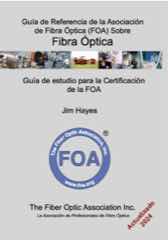
- Reference Books for FOA Certifications available on Kindle and iPad/iPhone as well as printed
  
We have created three new FOA books to be used in training for FOA certifications and as reference books for contractors, installers and end users of fiber optics. These books have full curriculum support, including free curriculum materials for teaching FOA certification courses. Because we are self-publishing these books using more modern "publish on demand" technology, they are easier to keep up to date, easier to buy and much, MUCH cheaper!
All are now available in print and electronically in Kindle and Apple iBook versions. The basic fiber optic book is also available as a self-study program in an Apple APP for iPad/iPhone/iPod.
Details on the new book each of the new books are at the book pages linked to the photos above.
RETURN TO INDEX
FOA iPad Apps
FOA LossCalc
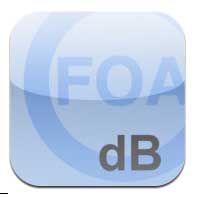 FOA LossCalc estimates the optical loss of a fiber optic link. This will save time for the installer of a fiber optic link needing to know whether test results are reasonable and/or make a "pass/fail" determination. It can also help the designer of a link to determine if communications equipment will operate over this link. FOA LossCalc estimates the optical loss of a fiber optic link. This will save time for the installer of a fiber optic link needing to know whether test results are reasonable and/or make a "pass/fail" determination. It can also help the designer of a link to determine if communications equipment will operate over this link.
By choosing the type of link (singlemode or multimode) and specifying the length of the fiber and numbers of connections and splices, it will calculate the end to end loss of the link. The app has default specifications for singlemode and multimode links or the user may create custom setups with specifications appropriate for any application. http://itunes.apple.com/us/app/foa-losscalc/id476262894?mt=8&ls=1
Self -Study in Fiber Optics
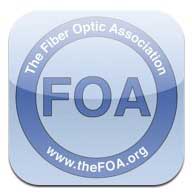 Our first app is a self-study version of the FOA Reference Guide to Fiber Optics. The FOA APP builds on the FOA basic fiber optic textbook to create an interactive learning environment that builds on the iBook electronic version of the book to add a guide to use for self-study and real-time testing that provides feedback on what you have learned and correct answers to questions answered incorrectly. Our first app is a self-study version of the FOA Reference Guide to Fiber Optics. The FOA APP builds on the FOA basic fiber optic textbook to create an interactive learning environment that builds on the iBook electronic version of the book to add a guide to use for self-study and real-time testing that provides feedback on what you have learned and correct answers to questions answered incorrectly.
The FOA APP is priced at only $9.99, same as the iBook, so the self-study program is free. Download it from the Apple APP Store with your iPad or iTunes.
http://itunes.apple.com/us/app/foa-guide/id434354283?mt=8&ign-mpt=uo%3D4
RETURN TO INDEX

The FOA has many videos on  , including two Lecture Series (Fiber Optics and Premises Cabling), Hands-On lectures on both and some other informational and instructional videos. For all the videos, go to the FOA Channel "thefoainc" or use the direct links below. , including two Lecture Series (Fiber Optics and Premises Cabling), Hands-On lectures on both and some other informational and instructional videos. For all the videos, go to the FOA Channel "thefoainc" or use the direct links below.
Three New Component/Installation Videos - Focused on MPO Connectors
FOA Lecture 41 Prefabricated (Preterminated) Fiber Optic Cabling Systems
Prefabricated or preterminated fiber optic cabling systems are made in a factory and installed with no need for termination or splicing. This video looks at how they are used, what components typically are used in manufacturing them and then how to design, install and use a prefab cabling system.
FOA Lecture 42 MPO (Multifiber, Array) Connectors and How To Test Them
MPO fiber optic connectors are multifiber array connectors that have from 12 to 72 fibers in a single connector. These connectors are typically used in prefab (preterminated) fiber optic cabling systems or parallel optics links. They have some unique characteristics in their design and use that users need to understand to implement them successfully. This video will look at their unique features and discuss how to use and test them in actual cable systems.
FOA Lecture 43 Managing Polarity of MPO Connectors (using the PanMPO Connector)
MPO connectors are complicated to manage because they have gender (male/female or as it is generally called "pin/no pin" versions) and keying (generally called "key up/key down"). This creates problems having the right patchcords to test or connect them in systems. In this video, we show the variations and how to accommodate them all with one connector - the Panduit PanMPO. (Thanks to Robert Reid and Panduit for samples to use in the video.)
For End Users - Who Think Fiber Needs Maintenance
FOA Lecture 39 Maintaining Fiber Optic Networks
Two New Applications Videos
To accompany new FOA certifications in FTTA and Data Centers
FOA Lecture 37: FTTA (Fiber To The Antenna) and Data Center Cabling
FOA Lecture 38: Data Center Cabling
FOA Product Demonstrations
In the June FOA Newsletter, we talked about the new 3M "disposable" cleaver, the Easy Cleaver, which is provided free with 3M connectors and mechanical splices that need cleavers. We got samples of the Easy Cleaver from 3M and tested them ourselves, and they work great. You can see for yourself how they work in this FOA YouTube Video about the Easy Cleaver.
We also tested the new Ripley/Miller FO-CF Center Feed Fiber Stripper and used it as an opportunity to show the other three common types of strippers, the Miller, MicroStrip and NoNik and how they are used. So you get a review of how to strip fiber and a product review of the new stripper in this FOA YouTube video about fiber strippers.
New FOA Lectures - Jargon and Jobs
How to Talk Fiber Optics - an introduction to fiber optic jargon - the perfect place to start learning about fiber optics.
Where Are The Jobs In Fiber Optics? FOA talks about all the applications for fiber optics, what jobs involve and the qualifications for the workers in the field.
What's A "Network"
That's a common question from fiber and cabling people. Even though they may be installing the cable plants for networks, often the nature of networks is not something they have been exposed to, other than perhaps the catch-all "star network" description. But what is a network? What does it connect? How does it connect users and how does it allocate the bandwidth to them? How do various network types vary?
We've been working on some new YouTube videos on networks, starting as we usually do on a new subject with the basics. We have these three videos online now, but watch for more.
Fiber Optics - Live! A series of videos that use lab demonstrations to show how optical fiber works.
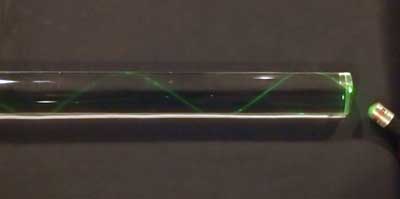
Prepolished/Splice Connector Termination (Panduit OptiCam)
Cabling Project Management - what's involved in a copper/fiber/wireless project -advice for the customer and the contractor
Hazards Of Counterfeit Cable
You may have read the stories we have written about the counterfeit "Cat 5" cable made from copper-clad aluminum rather than pure copper. Recently we tried an unscientific burn test on the cable compared to a known good UL tested cable and posted a video on YouTube. You can see the results below.
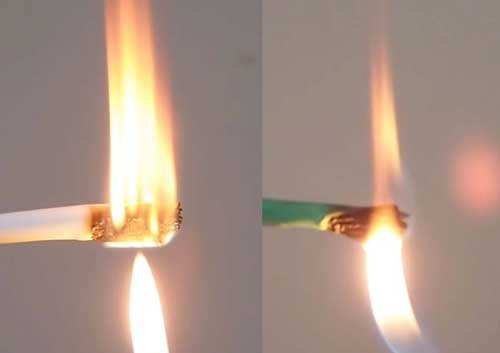
Counterfeit Cable Real UL-rated cable
The difference is obvious and the danger is real. Watch the video on YouTube: Premises Cabling Lecture 11: Counterfeit Cat 5 Cabling
View a complete list of FOA Videos with links to each video on YouTube.
View all the FOA Channel on YouTube.
RETURN TO INDEX

What's New in the FOA Online Fiber Optic Reference Guide?
We have been updating the Online Reference Guide to keep up with changes in the industry and adding lots of new pages of technical information.
Fiber For Wireless: FTTA and DAS
FOA Guide page on Metrology- the accuracy of measurements
Updated page on Data Centers
Le Guide de référence pour la fibre optique de la FOA est maintenant disponible en français.
Updates for new FOA certifications in FTTA and Data Centers
What do you do when you need to test fiber or cable on a reel? Here is a new page on Bare Fiber Testing
Couplers or splitters are used in FTTH and OLANs. How do you Test Splitters?
Tapping fiber has been a big topic in the news. How do you tap fiber?
The page on Optical LANs (OLANs) has been expanded with new material and links.
What's A Network? A simple explanation of network types and operation has been added to the FOA Online Guide.
We have updated the "Datalinks" page.
Three "Quickstart Guides" for fiber optic testing: cable plant & patchcord loss, power and OTDR
Learn More About OTDRs - Download a Free OTDR Simulator
More and more installers are being asked for OTDR testing but using these instruments is not easy. They are hard to set up properly and complicated to interpret the traces. Using the autotest function can lead to disastrous results! The FOA has a good tutorial on OTDRs on our Online Reference Guide and we added a free download of an OTDR simulator to the OTDR section so you can learn how to use an OTDR on your PC.
More New Info:
Links to manufacturers and distributors of fiber optic lighting products.
The FOA Online Fiber Optic Reference Guide has become very popular - perhaps the most popular technical website ever, typically with over 360,000 users downloading about 1.75 million pages in 2011! We continue updating materials regularly, keeping it as up to date as possible.
Find What You Want Using "Google Custom Search
 There's so much information on the FOA Tech Topics and Online Fiber Optic Reference Guide that even a well-organized Table of Contents isn't enough and when the material is always changing, an index is impossible to maintain. So the FOA is using the latest technology in search, Google Custom Search, which will allow you to search just the FOA Tech Topics and Online Fiber Optic Reference Guide for any topic you want to find more about. Try it! There's so much information on the FOA Tech Topics and Online Fiber Optic Reference Guide that even a well-organized Table of Contents isn't enough and when the material is always changing, an index is impossible to maintain. So the FOA is using the latest technology in search, Google Custom Search, which will allow you to search just the FOA Tech Topics and Online Fiber Optic Reference Guide for any topic you want to find more about. Try it!
Go to The FOA Online Fiber Optic Reference Guide.
RETURN TO INDEX
New Schools
The FOA welcomes the newest additions to our listing of FOA-Approved Training Organizations:
Electrical Training Institute
Commerce, CA
FOA Approved School # 649
Big Sandy Community & Technical College
Hager Hill, KY
FOA Approved School # 208-46
Ashland Community and Technical College
Ashland, KY
FOA Approved School # 208-45
Find a listing of all the FOA-Approved schools here.
Find A FOA-Approved Training Organization
Most inqiries we get regarding finding a FOA-Approved training organization want to know two things: what school is closest to me or what school offers the certifications I need. The FOA has about 200 training organizations we have approved worldwide so finding the right one can be difficult! We've been looking at ways to make it easier, and we think we've got a good solution. In fact we have two solutions.
First we have added a sortable table of all the FOA-Approved schools.
You can also use our FOA Google Map to find FOA-Approved schools.
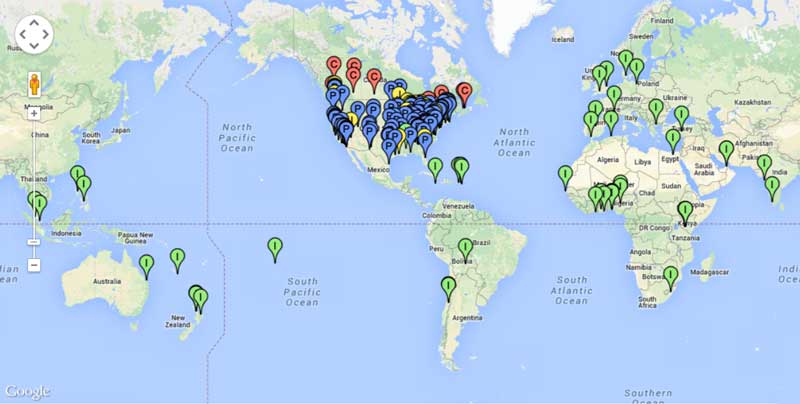
What Should A Fiber Optics or Cabling Tech Know and What Skills Do They Need?
FOA certifications are based on our KSAs - the Knowledge, Skills and Abilities that techs need to succeed. Read the FOA KSAs for fiber and cabling techs.
School News
Feedback
We always enjoy feedback, especially when it shows how great some FOA instructors are. These came from students of Tom Rauch, an instructor at BDI Datalynk:
"I took your fiber optics certification courses this past March. I just wanted to let you know that in two weeks I start working as a fiber optic technician with ___ up in ___. You mentioned on the first day of the course that there is always one guy in class who had rubbed his last two nickels together to be there and, in that instance, I was that guy. Now I'm going to be able to provide for my family like never before and I owe it to the certification that I received from you and BDI Datalynk. I just wanted to thank you again."
"Thanks to our tremendously knowledgeable and patient instructor Thomas Rauch, who was not only generous in sharing his wealth of information, but he did so with ease, humor and in a way that invited curiosity and participation. He was encouraging and proud of our accomplishments and helped us learn from our mistakes in a way that did not break our confidence, rather it pushed us to better results the next go around. The hands on labs were just AWESOME!" Just thought you should know what a class act you have representing you in his travels..... but then again you probably already knew that! : )
In almost 19 years at Verizon and having held numerous positions, I have gone through many training sessions. I cannot remember ever having been actually looking forward to coming back to class quickly after lunch, to get back to the hands on activities, and walking away with the sense of empowerment that the information presented was not only relevant but dead on point accurate! I will be signing up for the Outside Plant class on March! I can't say enough good things about Tom and his impact! Feel free to quote me, I can only imagine that he will open so many doors and change so many lives in the years to come, with his style of teaching! Great experience, awesome job!"
IBEW and FOA Partner on Fiber Optic Training
The International Brotherhood of Electrical Workers (IBEW) and the National Electrical Contractors Association(NECA) through the National Joint Apprenticeship and Training Committee (NJATC) in a partnership with the FOA has published a new textbook for training IBEW apprentices and journeymen in fiber optics. The new textbook uses the material from the FOA Reference Guide To Fiber Optics with new material and photos from other NJATC training partners.
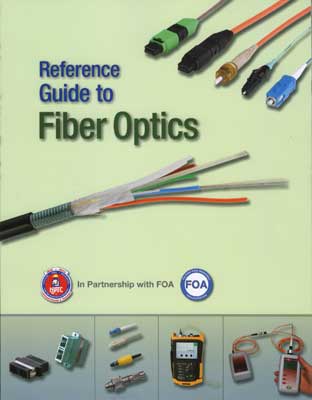
FOA is pleased to have been able to assist the NJATC in the development of this new text. FOA has been a NJATC training partner for many years, including offering instructor training at more than 16 of the NJATC's summer National Training Institutes. A majority of IBEW NECA contractors do fiber optics and low voltage, especially for applications that combine electrical and communications cabling like smart grid, alternative energy, traffic controls, data centers, etc.
Quote from one of our certified instructors: I want to thank you and your organization for all the resources you provide for the students and the opportunity to offer the certification to the students. The fact that you published the book yourself to get the cost down and the unlimited free resources on your website shows a commitment to the public that is second to none. I let it be known to the students that the FOA is the best in the industry at supplying knowledge and resources related to the communication industry. I look forward to passing on the information that you provide for the industry.
Great Video About An FOA School And Their Training
BDI Datalynk trains at the Unversity of Central Florida. UCF created this incredible video on the BDI Datalynk program. It shows the power of what they offer on campuses around the US.
Watch the video here: http://www.ce.ucf.edu/Program/2583/Fiber-Optics-Network-Certification-Courses-Non-credit/
For more information, contact Bob Ballard, CFOS/I, BDI DataLynk, LLC, A Vietnam Veteran-Owned Company
www.bdidatalynk.com, Ph: 512-785-9024
RETURN TO INDEX
Good Question! Tech Questions/Comments Worth Repeating
Real Questions From FOA Newsletter Readers
Test MMF at 1550nm?
Q: How we can accurately test multimode cable at 1550nm.
A: Not much MM is used at 1550, but there are some ways to test it.
1. Get a test equipment manufacturer to make you a 1550nm LED source. It would cost a fortune.
2. Use a SM 1550nm laser source with a ~5m MM launch cable. On the launch cable use a mandrel wrap or serpentine mode conditioner to scramble modes as much as possible. Then use standard double ended test with a MM receive cable. This is the best solution even though it will be under-filling the modes in the MM cable.
3. Use an OTDR at 1550 nm with a MM launch cable but it will need to be ~1km. The problem will be the ~17dB loss from MM to SM at the OTDR but if it has enough dynamic range, it will still work. You may need a longer test pulse width to get enough range so you need the long launch cable but may have resolution problems on the cable under test.
Estimating Fiber Optic Work
Q: Could you help me to find a source of installation man-hours for this type of work? I run into estimates requiring this often.
A: There is a page on estimating on the FOA Guide that has information that may be useful.
See http://www.thefoa.org/tech/estimate.htm at the bottom of the page.
Using Fiber In Hazardous Environments
Q: I have a question regarding an installation at a fuel depot. Equipment at the loading bay communicates with a PLC located some distance away in a MCC room, via Fibre Optic cables.
The Fibre Optic converters and other electronic equipment, in the bay, have been mounted in an Exd (Explosion Proof) enclosure. Space is limited in the enclosure so my proposal is to splice the Fibre Optic cables in an external splicing box with “Breakout Cables” into the Exd enclosure, through Exd glands. Can the splicing box be a normal PVC / Steel enclosure or must it also be Exd rated?
A: Since there is no electrical service in the fibre splice closure, I would assume a regular fiber closure would be permissible. There may be some local ordinances of the owner of the facility may have other requirements however. Of course you need to worry about fusion splicing in a hazardous area. Fusion splicing in such areas are typically not permissible… what installers do to overcome this issue is to use pre-terminated distribution, breakout or ruggedized zip-cord cables and as a last resort, mechanical splicing.
Testing Different Types Of Same-Sized Fibers
Q: Should one worry about using matched fiber types when testing cables? E.g. don't test OM3 fiber with OM4 reference cables or vice versa, or mizing OS1 and OS2 singlemode.
A: We’ve never tried to do controlled tests of OM3 v. OM4 or OS1 v. OS2. It would be very difficult to get the measurement uncertainty down to where the differences could be seen, I suspect. Just think about finding two fibers, one OM3 and one OM4 with exactly the same core diameter.
One can certainly see differences between using good or bad cables for reference launch/receive cables, but isolating each variable is difficult.
We did tons of tests on some of these issues, like modal control in MM fiber or source wavelength back 20-35 years ago, as part of the early development of standards at EIA (before TIA). What many users fail to understand is that you have a lot of variables in fiber optic testing and controlling one is not going to be the “silver bullet” to make it perfect. That’s why FOA did the metrology page - trying to explain that the issues are many and often uncontrollable or unknowable!
Indoor/Outdoor Cable
Q: Can you use an indoor/outdoor tight buffered fiber cable in an in-ground conduit application? The fiber is not gel-filled.
A: Indoor/outdoor cable will generally have a dry water-blocking tape or powder - not gel on tight buffer fiber - and is OK for underground conduit. But always check with the manufacturer when in doubt.
Fiber On A Pipeline
Q: We would appreciate if you could please advise me on the following aspects on FO cable intended to be used for data transmission for a cross-country hydro-carbon pipeline:
1. What is the maximum length of a single run of FO cable that can be produced, transported, handled & installed, considering any practical constraints of production/transportation/ handling/ installation?
2. What are the methods by which the long-haul FO cables (kilometres long) are usually i) transported (series of cable drums on pallets?), ii) handled & iii) installed (onshore as well as offshore)?
3. Any other precautions/ word of advice in the above case?
A: Most manufacturers have available lengths of “regular” cable up to about 12km, but it depends on the cable type - the weight and bulk is the problem. Submarine cables are built on board ships and have lengths of thousands of km, but they are a very special case. Once you have an idea of how many fibers you need and the cable type, you can talk to manufacturers to get a more precise answer.
Transportation is by cables on reels transported on special trucks that have spindles to pay out the cable or cables on spools transported with the cable spools upright, sitting on the edges, not the sides, so they can be easily rolled around or put on a spindle to pay out for installation. Upright spools can also be picked up by forklifts without damaging the cables.
I would assume that if you are building a pipeline, you have good roads alongside it so weight is not a problem and bigger spools can be accommodated.
Rural Network Opex (Operating Expense)
Q: I'm looking for some resources that will help me figure out the operating costs of a rural fiber network. I would appreciate it if you could point me in the right direction.
A: Estimating OPEX is very difficult unless you are a network owner with historical data. Fiber itself has little maintenance. Properly installed, it has no routine maintenance requirements and can operate for decades without needing assistance. See http://www.thefoa.org/tech/ref/user/maintain.html
Repairs are the biggest expense for the cable plant - if you have aerial cable, it can be damaged by vehicles hitting poles or - at least out West, but unlikely in MA, target practice - underground cables can be flooded and frozen in the North or dug up by contractors who never heard of "Call Before You Dig."
Overall network OPEX is the usual provisioning, adding subscribers, upgrading equipment, etc. - nothing to do with the fiber network beyond construction to add subscribers but simply running a system. That all ties into what kind of system(s) you are running.
Planning for the environment, future expansion and adding subscribers is important to keep costs low. We're working with a rural system - an electrical utility in this case - in the CA mountains on a broadband/smart grid project that's probably similar to you. (We know your region, we lived in Boston for 30 years before moving to CA in 2003, had a son go to Hampshire and my family was from the area starting 330 years ago). For your area, the important issues are preparing for the weather and ensuring the contractors are used to designing/installing the cable plant that must withstand freezing cold to blistering hot weather!
Getting Old Cables Out Of Conduit
Q: How do you get old cables out of a conduit when they are stuck?
A: Usually we are concerned about reducing friction when pulling cables through conduit, but sometimes you need to get them out. Here is a page from American Polywater the leading lubricant company with advice on the subject.
OTDRs For MM Fiber?
Q: I watched the OTDR presentation and would like to clarify some conditions of the standard OTDR test. I am sure that single mode fibers are testable by OTDR. Does the test apply to multimode fibers?
A: Yes OTDRs are used for multimode fiber, but because many MM links are short and OTDR distance resolution is often not very good, the usefulness of such measurements may be limited.
Many of the technical questions we get here at FOA relate to OTDR testing and often resolution is an issue.
If you want to use an OTDR to test short MM links, you need a very high resolution OTDR. Testing is always better at 850nm because the trace has more amplitude and can use less amplification for better resolution. Besides there is little use of MM at 1300nm anymore.
The second issue is mode power distribution - see http://www.thefoa.org/tech/ref/testing/test/MPD.html The laser source of the OTDR launches mainly into the center of the fiber so any loss at a connector is minimized. That affects reflectance measurements too but I’ve never seen it analyzed.
Finally, most MM users are novices, often sold a device they have little training on, so they hit the “auto test” button and store th results because they have no idea what the instrument is doing. Not a good idea…
Storage of Optical Cable
Q: I would like to know that the procedure for long time storage and preservation of fiber optic cables.
A: The preferred guidelines are fairly simple - store the cable on the reel in a indoor dry location where the temperature is moderate - say 10-40deg C- and humidity is also moderate. Have the spools sitting on the edges or on a spindle (see Nexans guidelines here).
OTDR Loopbacks
Q: We are looking at running a OTDR test across a pair of fibre’s but instead of running a OTDR test from A-B and then B-A, we are looping the fibres at exchange B and doing the OTDR test at on F1 &2 at Site A. We have launch cords and trail leads on Fibres one and two but I’m wondering what length of fibre should the loop be, would 50m be acceptable. Typically the sites are 10-20km apart.
A: Loopback tests are a good way to simplify OTDR testing. On a 10-20km run, the loopback needs to be long enough to allow both connections on the far end to be seen, so it depends on the pulse width of the OTDR. I suspect 50m is too short - I’d say use 500-1000m to ensure all the data is valid.
Manufacturing Guide?
Q: Is there a guide published by FOA that provides insight as to the process of fiber optic manufacturing? It's my understanding that the guide stresses quality and controls to ensure performance and reduce product loss?
A: We do have a guide for manufacturers. It is mostly aimed at communications systems and components manufacture. Here is a link to download it.
How Long Does Termination Take?
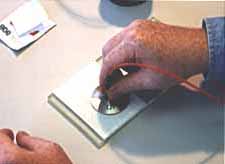
FOA received a request from a consultant recently wondering if we had information on the termination times for fiber optic cables. After some looking in our archives, we realized we had a document online that compared times for various fiber optic termination processes. The paper was written after several FOA instructors did a comprehensive time and motion study on termination processes. The document is about 15 years old but still relevant.
You can read it here in the FOA Online Guide.
Testing Connectors (From A Patchcord Maker)
Q: What are the chief defining standard(s) that specifies connector and assembly IL (insertion loss) and RL (return loss or reflectance) for both SM and MM fiber?
A: The description on our Guide is here: http://www.thefoa.org/tech/ref/testing/test/conntest.html
FOTP-34 covers connector testing as a qualification test for the type of connector - basically a "destructive" test for connector manufacturers.
Reflectance is described on that page and here also: http://www.thefoa.org/tech/ref/testing/test/reflectance.html
Testing an assembly like a patchcord is covered under FOTP-107 http://www.thefoa.org/tech/ref/testing/test/FOTP-171.html
Basic Tests For Fiber Optic Cable Plants
Q: I did some research and I noticed that there is a bunch of tests that can be done to fiber optics and I was wondering if there is a list of primary tests that can be done as a basic test.
A: Fiber optic testing does have a hierarchy of tests.
- At the top of the list is "insertion loss" testing which uses a light source and power meter to test the fibers in the same way that a communications system transmits over the fiber. It is a simple test and the equipment needed is inexpensive.
- Techs will also use a microscope to inspect the fiber optic connectors for dirt and damage, a big issue for fiber.
- The instrument called an "OTDR" takes a snapshot of the fiber using a technique like radar. Most outside plant cables are tested with an OTDR and the data ( the snapshots are called "traces") stored for future reference. OTDRs are more expensive and require more training to use properly.
Here is a link to a page on the FOA Guide site that explains the technical,details: http://thefoa.org/tech/ref/testing/test/OFSTP-14.html
FOA also has information just for users of fiber optic networks, see http://thefoa.org/tech/guides/UG3.pdf
How to Clean POF (plastic optical fiber)
Q: I heard that plastic fibres such as PMMA can suffer damage from cleaning from an alcohol solution. Are there alternate cleaning solutions available for these types of fibres."
A: You can use a 10/90 mix of isopropyl alcohol/water. Typically use with a lint free swab. (from out POF consultants)
Testing Bare Fibers With OTDR
Q: We are starting to test some OPGW cables. We have an OTDR but we don’t find some reusable connectors. If we have to test an OPGW with 48 fibres, we can’t set up 48 SC connectors!
Are there some reusable connectors in the commerce?
A: I assume you mean you need to test with a bare fiber on the OPGW. For testing bare fiber, use a splice, not a connector. Have a long pigtail on the OTDR as a launch cable, long enough for the test pulse to settle, say 100-500m, then use a splice for a temporary connection. You can fusion splice the fibers then cut the splice out or use a removable splice like the Corning Camsplice (http://catalog.corning.com/opcomm/en-US/catalog/ProductDetails.aspx?cid=&pid=17929&vid=18219)
If you use a mechanical splice, you need a high quality cleaver just like with fusion splicing and after several uses, you need to add more index matching gel or liquid - mineral oil works OK. See the FOA page on Testing Bare Fiber.
Is A Flashlight Test Adequate?
Q: I contracted a firm to install an OM3 of 200 meters. On one end I have an SFP 1000SX ,on the other a 1000SX converter from optical to UTP. We made pings but they never reached, and I didn’t see the laser at the extreme of the fiber. They promised me to send me the certification they supposely made ,though they assured me the fiber is ok, because WITH A FLASHLIGHT THEY SENT WHITE LIGHT FROM ONE SIDE TO THE OTHER AND IT WAS VISIBLE. I saw the light too, and I thought the culprit was my switch or my SFP. I want to know: is this a good demonstration that the fiber is ok?
A: A visual continuity test is not adequate - your eye is not calibrated! The power of the lamp is unimportant as each eye’s sensitivity is different. And your eye probably cannot see the light from a 850nm VCSEL source - most people’s eyes are not sensitive at that infrared wavelength. The installer should have tested the link with a light source and power meter (http://www.thefoa.org/tech/ref/testing/test/OFSTP-14.html) and given you the loss in dB. The connectors should also be inspected with a microscope to ensure proper polishing and cleanliness (http://www.thefoa.org/tech/ref/testing/test/scope.html). If the SFP output is -6dBm, what is the power at the receiver? 1000base-SX is supposed to work with 4.5dB loss (see http://www.thefoa.org/tech/Linkspec.htm). The fiber loss should be ~0.6 dB, so you must have >4dB connector losses! That says bad installation! The 1000SX link should work over 200m if the fiber has been properly installed.
Older Fiber?
Q: I have some 62.5 mm and sm inside fiber plant over 20 years old. When is a good time to upgrade?
A: When you need to or have to. If it's working OK, there is no need to upgrade!
"Connector Loss" or "Connection Loss"
Q: I have always counted the loss of a connector as .75 dB (568B-3) and 1.5 for a mated pair. Is that correct?
A: While the industry always says "connector" loss, it is actually "connection" loss. As we explain in the page on termination and splicing (http://www.thefoa.org/tech/ref/basic/term.html) When we say "connector" loss, we really mean "connection" loss - the loss of a mated pair of connectors, expressed in "dB." Thus, testing connectors requires mating them to reference connectors which must be high quality connectors themselves to not adversely affect the measured loss when mated to an unknown connector. This is an important point often not fully explained. In order to measure the loss of the connectors you must mate them to a similar, known good, connector. When a connector being tested is mated to several different connectors, it may have different losses, because those losses are dependent on the reference connector it is mated to."
The TIA spec of 0.75dB is for a mated pair of connectors. If you have been passing connectors tested @ 1.5dB loss....you may have some very bad connectors in your cabling!
Microscope Magnification (11/13)
Q: I am doing a lot of fiber optic jumpers for control systems, either single mode or multimode. I want to get a scope to inspect the ends after I clean them would you recommend a 200X, 400X handheld or one similar to a Noyes OFS 300 200C?
A: We prefer to use lower magnification and have a wider view so I can see more of the ferrule to determine its condition. You can see the fiber effectively at 100X but 200X may be better. 400X may be too much for most tasks like inspecting for cleanliness, but may be good if you are polishing SM for good reflectance. We've used the Westover units for years because they offer two different methods of illumination - direct and at an angle. If you are doing a lot of patchcords, I recommend a video microscope. I've used the Noyes unit that interfaces to a PC to create the FOA Microscope Inspection YouTube video here: http://www.youtube.com/watch?v=IyumH8CiUPQ&feature=youtu.be and it works well.
Recycling Cabling
Q: Who can I contact regarding recycling cable I am removing from a building?
A: Here are some people who say they recycle fiber optic cable or at least know how to do it:
http://www.scottrecycling.com/complete.html
http://www.scrapmonster.com/selloffer/fiber-optic-cable/10400
http://www.dnvkema.com/services/ces/hse/recycling/recycling-cables.aspx
http://tmscrapmetals.com/Recycling.html
Tech Hint: Did You Know You Have A Fiber Optic Tester In Your Pocket?
Yes! That old mobile phone has a camera which may be sensitive to infrared light - lots more than your eye - and can detect light in an optical fiber or from a transmitter. Chris Hillyer,CFOT/CFOS/I, Master Instructor, Northern California Sound & Communication JATC sent us some photos showing how this works. See below or the video now on YouTube. Update: You should check out your old cell phones before you recycle them. We've found older models use sensors which are better at infrared than the newer ones which take better pictures. This is a good use for your old cell phones hiding in the drawer!
Fiber Cleaning
This is a topic we keep reminding everybody about, and here is why:
From a contrator in the Middle East: Here some samples of the connectors for SM fiber already installed in the system we were testing.
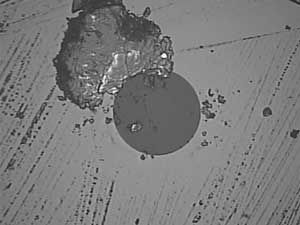 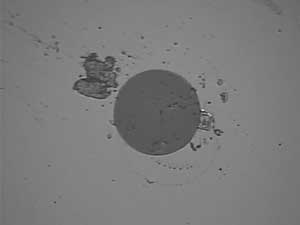
As you can see, the dirt is large compared to the size of the fiber (dark gray), and the core (not visible here) is only 9/125 of the overall diameter of the fiber! More on cleaning. See Product News below for links to vendors of fiber cleaning products.
See news about Fiber Optic Cleaning Videos on YouTube by ITW Chemtronics below.
Fiber Optic Cleaning Videos on YouTube
See news about Fiber Optic Cleaning Videos on YouTube by ITW Chemtronics three fiber optic cleaning videos on YouTUbe covering Dry Cleaning, Wet-Dry Method, FiberWash and Combination Cleaning. They are good explanations of cleaning processes - the Wet-Dry is especially interesting.
- Westover Application Notes And Cleaning Video
- Westover has several application notes on inspecting and cleaning fiber optic connectors. The video is a big file (50+MB) but a good tutorial.
- Download page: http://www.westoverfiber.com/Support/downloads.php
-
Measurement Uncertainty: Everyone testing fiber optics should understand that every measurement has some uncertainty - whether you are measuring loss, length, wavelength, power, etc. Knowing that uncertainty is very important to interpreting the measurement. It's worthwhile to read and understand the issue of measurement accuracy covered in this page of the FOA Online Fiber Optic Reference Guide.
RETURN TO INDEX
Worth Reading or Watching:
FOA "Quickstart Guides"
In our continuing quest to help people understand how to test fiber optic cable plants and communications systems, we've created two more "QuickStart Guides to Fiber Optic Testing." They are simple, step-by-step guides on how to test fiber optic cable plants, patchcords or single cables using insertion loss or OTDR techniques and optical power from transceivers. It's as straightforward as it can get - what equipment do you need, what are the procedures for testing, options in implementing the test, measurement errors and documenting the results.
It can't get much simpler.
Send anybody you know who needs to know about fiber optic testing here to learn how it's done in a few minutes.
Testing Fiber Optic Cable Plants And Patchcords
Testing Fiber Optic Cable Plants With An OTDR
Measuring Optical Power In Communications Systems
New Edition Of Eric Pearson's Fiber Optic "Cookbook"
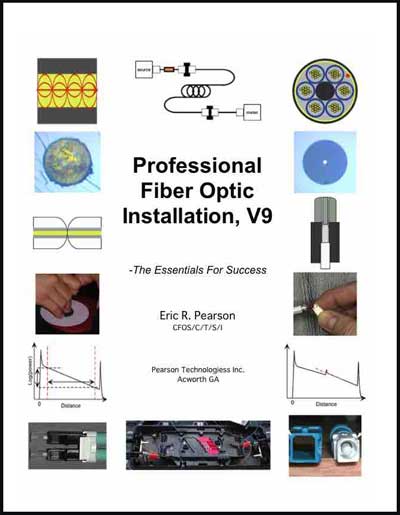
Eric Pearson of Pearson Technologies Inc. announced the availability of Professional Fiber Optic Installation, v.9. This recently updated training, field, and reference text is a comprehensive presentation of the information essential to successful fiber optic installation. This text assists the installer in achieving the three elements of success: low power loss, high reliability, and low installation cost. This text is the ideal tool for three types: those who wish to become professional fiber optic installers; for instructors who want to use the most comprehensive training manual available; and for those who want to pass the Fiber Optic Association CFOT and CFOS/C/S/T certification examinations. Continuously developed and tested over the last 24 years during both fieldwork and training presentations, this text includes both the information essential to understand the reasons for the installation rules and detailed procedures for installation, inspection, certification, and testing of cables, connectors, and splices.
The new edition, #9, is available on Amazon.com.
TE Connectivity Components For FTTH
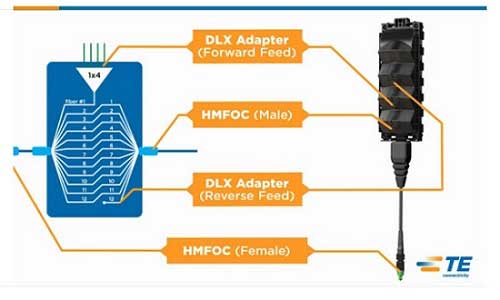
FIBER INDEXING: ULTRA-FAST FTTH DEPLOYMENTS
TE’s fiber indexing solution offers new approach to FTTH deployments that significantly speeds fiber construction while reducing fiber cable, engineering and inventory management requirements. While typical FTTH deployments require labor-intensive engineering and measurement with custom-length fiber cables, TE’s fiber indexing architecture leverages standardized building blocks – connectorized and indexed service terminals with hardened multi-fiber optical connectors – to create a plug-and-play network that is faster and easier to deploy.
Website, White Paper
AVAGO Offers Data Center Tech Information
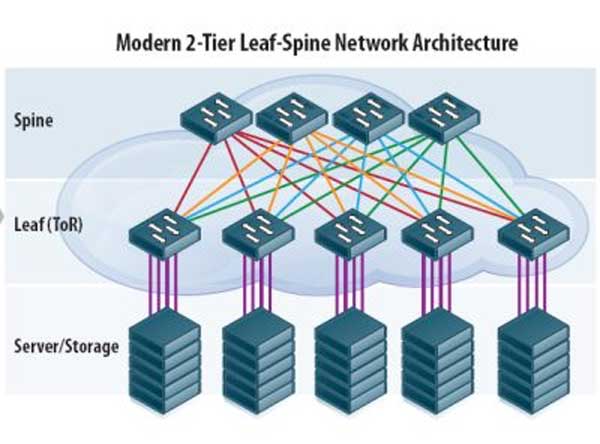
Transition to Leaf-Spine Networks: Data centers worldwide are undergoing major transformations to keep pace with current needs and future-proofing systems to support future needs. The prevalent trend in modern data centers is the architectural shift from a traditional 3-tier network to a cloud-based 2-tier network called the leaf-spine network.
Moving massive data around the data center requires a robust infrastructure that is capable of handling high bandwidth data delivery to and from storage endpoints, servers, top-of-rack (ToR) switches and core switches. Avago Technologies offers data center customers a broad range of cost-effective pluggable module and board-level solutions that address the growing needs of modern data centers. These solutions include a comprehensive portfolio of fiber optic transceiver, transmitter and receiver module solutions supporting 1G, 10G, 25G, 40G and 100G from 20m to 10km link distance.
- Request AVAGO Data Center Fiber Optic Network Brochure
Getting Cables Out Of Conduit
Usually we are concerned about reducing friction when pulling cables through conduit, but sometimes you need to get them out. Here is a page from American Polywater the leading lubricant company with advice on the subject.
What Is The FOA?
Hear FOA President Jim Hayes tell the FOA Story in a 2-part interview by Sound & Video Contractor Contributing Editor Bennett Liles. It tells about the FOA history, goals and achievements.
Part 1: http://svconline.com/podcasts/audio/fiber_optic_association_part1/index.html.
Part 2 http://svconline.com/podcasts/audio/inside-fiber-optic-association2-0924/index.html.
New Textbook On Cleaning Fiber Optic Connectors
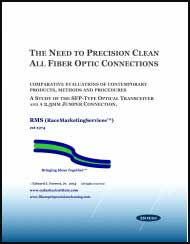
As fiber optic networks become faster and link margins lower, cleaning fiber optic connectors has become more critical. Now there is a book that gives really good information on cleaning from a real expert.
Ed Forrest retired from ITW Chemtronics recently after many years of being their expert on cleaning fiber optic connectors. Ed has been one of our best contacts on the subject because his knowledge is both broad and deep. When he retired, we suggested he write a book on fiber optic cleaning and he took our advice.
Ed's book is like a cookbook, looking at specific cleaning recipes, plus evaluating the tools commonly used for cleaning. It's also in color which makes it easier to see what is being done, although it makes the book a bit more expensive.
Now you can buy The Need to Precision Clean Fiber All Optic Connections, A study of the 'sciences of cleaning', contemporary cleaning products, methods and procedures by Edward J Forrest Jr. The book is available online from CreateSpace, the same publisher FOA uses. Go here for more information on the book: https://www.createspace.com/5120367
What Happens To Old Fibers?
In a recent web search, we found this article from Corning, reprinted from a IWCS presentation in 1995. It discusses extensive tests on a 1984 cable installed in the northern US to see how it had degraded in almost 10 years. It is interesting to see how the fiber survived OSP exposure. Read it here.
Australia's Standard Is Comprehensive Guide To Customer Cabling (Get your copy free)
In answering a recent technical questino, Trevor Conquest in Australia pointed to the Australian Standard "Installation Requirements For Customer Cabling." When we checked, it is on the web and can be downloaded. It's a big book - 220 pages - full of details for fiber and copper installations. We recommend you download yourself a copy - go here.
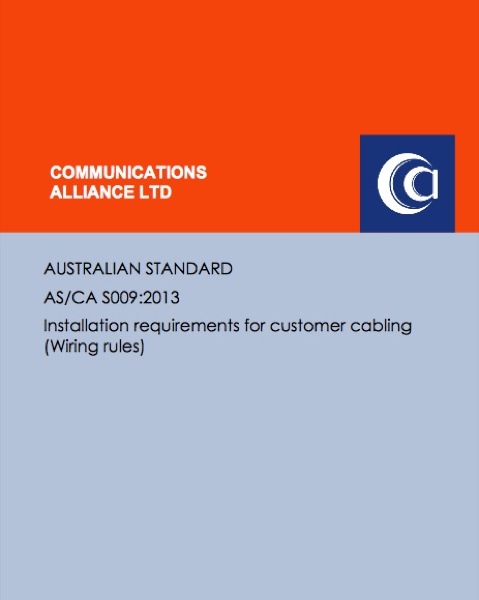
Demystify fiber inspection probe technical specifications - From EXFO
The intent of this application note is to promote a better understanding of video inspection probe specifications and features. Properly understanding the key specifications and features will greatly facilitate the decision process involved in acquiring such devices. Understanding the key aspects of fiber inspection probes will also help users understand how fiber inspection probes operate, thus enabling them to maximize the full potential of these devices. Read more.
Where In The US Do Contractors Need Licenses For Fiber Optics?
We often get asked where in the US do contractors doing fiber optic installations need licenses. We found a good website for that information, the NECA -NEIS website. You might remember NECA-EIS, as they are the partner with the FOA in the NECA/FOA 301 Fiber Optic Installation Standard. NECA is the National Electrical Contractors Association and NEIS stands for National Electrical Installation Standards. They have a very easy to use map and table that gives you data on every state in the US, so mark these pages for future reference.
NECA/NEIS
http://www.neca-neis.org (See “State Regulations”)
http://www.neca-neis.org/state/index.cfm?fa=state_regs (all electrical licensing)
Low Voltage: http://www.neca-neis.org/state/index.cfm?fa=specialty_licensing
How Is Fiber Manufactured?
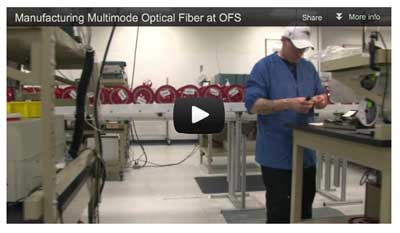
OFS invites you on a tour of their multimode fiber manufacturing facilities in this new 5-minute video. You will see their highly automated manufacturing operation in Sturbridge, Mass., including their patented MCVD preform fabrication process to fiber draw and final product testing. With a technological heritage dating back to AT&T and Bell Labs, OFS has been manufacturing high-quality multimode fiber since 1981.
Watch the video here.
Want To Know Where Submarine Fiber Optic Cables Run?
There is a good map online by TeleGeography you can access here.
Benchmarking Fusion Splicing And Selecting Singlemode Fiber
We've been asked many times "How long does it take to splice a cable?" It's not a simple answer as it varies with the number of fibers in the cable and the work setup, including whether one or two techs are working at a job site. FOA Master Instructor Joe Botha of Triple Play in South Africa did his own analysis based on decades of experience both splicing cables and teaching others how to do it properly. This is one of the best analyses we have seen because Joe includes prep times as well as splicing times and differentiates between one tech and two techs working together. He adds some other tips on fusion splicing too. This should be mandatory reading for every tech and given to every student! Here is Joe's splicing analysis.
Joe also has an excellent writeup on how to choose singlemode fiber that helps understanding the different types of G.6xx fiber. Read it here.
And you will want to read Joe's report on splicing different types of SM fiber, including bend-insensitive (G.657) fiber. Read it here.
Free - Mike Holt's Explanation Of The US National Electrical Code (NEC) For Communications Cables
Mike Holt is the acknowledged expert of the US National Electrical Code (NEC). His books and seminars are highly praised for their ability to make a very complicated standard (that is in fact Code - law - in most areas of the US) easily understood. Part of the appeal is Mike's great drawings that make understanding so much easier. Mike makes Chapter 8 of his book available free. It covers communications cables, telephones, LANs, CATV and CCTV, for premises applications. Even if you live in a region or country where the NEC is not the law, you may find this interesting.
Download Mike's Chapter Here.
Fiber Optic Cleaning Videos on YouTube
ITW Chemtronics has three fiber optic cleaning videos on  covering Dry Cleaning, Wet-Dry Method, FiberWash and Combination Cleaning. They are good explanations of cleaning processes - the Wet-Dry is especially interesting. covering Dry Cleaning, Wet-Dry Method, FiberWash and Combination Cleaning. They are good explanations of cleaning processes - the Wet-Dry is especially interesting.
- Westover Application Notes And Cleaning Video
- Westover has several application notes on inspecting and cleaning fiber optic connectors. The video is a big file (50+MB) but a good tutorial.
- Download page: http://www.westoverfiber.com/Support/downloads.php
-
A Documentary Treasure on the History of the Internet
15 minutes of a rarely-seen BBC documentary demolish the myth that ARPAnet was inspired by nuclear war, and explain the far more intriguing truth.
http://www.technologyreview.com/blog/mimssbits/26719/?nlid=4433
Ensuring Distance Accuracy On OTDR Measurements
By JDSU.
JDSU Reference Guide to Fiber Optic Testing
Volume 1 focuses on Basic Fiber testing and Volume 2 is geared toward fiber optic installers, project managers, telecom technicians and engineers who need to understand fiber networks. Volume 2 also covers Chromatic Dispersion, Polarization Mode Dispersion, Attenuation Profile and Fiber Link and Network Characterization. A 3rd volume, a glossary of fiber optic terms, is also available for download.
This is a "MUST HAVE" for all fiber optic techs. Download your free copies here.
We used this book as one of our references in creating a new page in the FOA Online Reference Guide on chromatic dispersion (CD) and polarization-mode dispersion (PMD).
-
- Download yourself a copy and read it!
-
Good Technical Website For Installers
American Polywater (http://www.polywater.com/) has one of the best technical website for cable installers. Check out their website, especially “Videos,” “Engineer’s Corner” and “Calculators.” http://www.polywater.com/NNNBSL.pdf
Fiber Optic Safety Poster
We've had numerous requests to reprint our guidelines on safety when working with fiber optics, so we have created a "Safety Poster" for you to print and post in your classroom, worksite, etc. We suggest giving a copy to every student and installer.
RETURN TO INDEX

" Heard on the Street" is a monthly online newsletter from Frank Bisbee of Communications Planning Corporation that covers the telecommunications and cabling businesses. Each month includes news from manufacturers, trade associations and professional societies like the FOA. You can read the current issue and back issues online.
IGI, a major market research and technology reporting company (the "Active Optical Cables" below) is offering a a free one year subscription to one of our fiber optics newsletters to FOA members. All they have to do is to send IGI an e-mail stating which newsletter they would like to get. See http://www.igigroup.com/nl.html for a listing of IGI Newsletters.
RETURN TO INDEX
-
FOA Tech Topics -
A Fiber Optic Tester In Your Pocket? (See the video on  ) )
Yes! The camera in your cell phone is sensitive to infrared light - lots more than your eye - and can detect light in an optical fiber or from a transmitter. Chris Hillyer,CFOT/CFOS/I, Master Instructor, Northern California Sound & Communication JATC brought this to our attention.
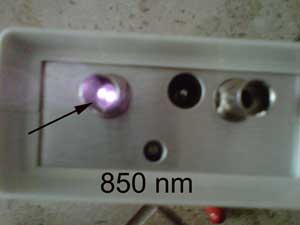 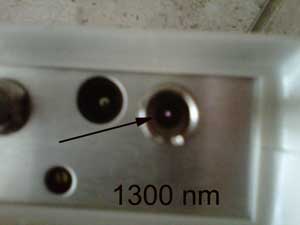
If you have an old cell phone, try it too. Our experience is that older cell phone cameras have better sensitivity at IR wavelengths than newer phones, so you may want to toss that old phone into the toolbox.
RETURN TO INDEX
Product News
New Company Focuses on FTTA Testers
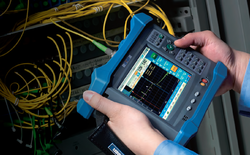
Deviser Instruments brings an extensive portfolio of innovative, high-quality, value-packed test and measurement solutions to communications service providers and equipment manufacturers worldwide. For more than 25 years, communications service providers have relied upon Deviser’s products to deliver reliable, high-performance cable, satellite, wireless, fiber optic and telecommunications services to their customers. Over the last 12 years, Deviser has been an OEM supplier of test equipment to tier 1 communications service providers in North and South America.
Products include a high res OTDR and CWDM testers.
Learn more.
YOKOGAWA OTDR Has Extended range, High Resolution And Multitasking
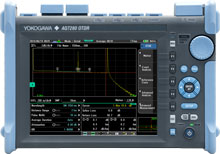
One OTDR manufacturer you don't hear as much about is YOKOGAWA (formerly ANDO) which is too bad - they make some of the best OTDRs, exemplified by this new model AQ7280. Need long range - how about 50dB. High resolution - 0.6m dead zone. Like touch screens, but for some functions want hard buttons, it's got that. Options for VFL, microscope, light source and power meter, etc. - it has that too.
But the unique aspect of the YOKOGAWA AQ7280 is it offers multitasking - you can let do a trace with long averages while you inspect connectors, make power readings, use the VFL or other functions.
More info on the YOKOGAWA AQ7280.
Need A Fiber Optic Cable That's Waterproof And Floats?

Linden Photonics can help you. The specialize in special underwater cables for towed vehicles or ROVs. Read more.
How To Make Space For More Cables In Full Conduits
Traditionally, underground fiber has been placed in plastic innerducts in conduit. About a decade ago, MaxCell "fabric" innerducts were introduced. They provided the protection needed during installation and greatly increased the availabe space in conduit. Recently, the company has introduced an interesting technique to remove plastic innerduct in place to make more space for cables in current ducts.
Here are photos from a MaxCell YouTube video showing what we are describing.
Before, with innerduct in place:
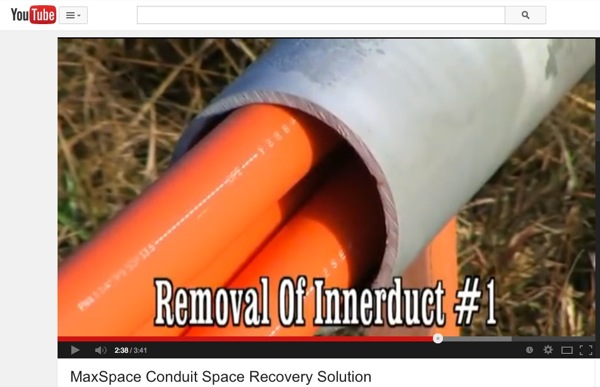
After, with the MaxCell innerduct and more cables:
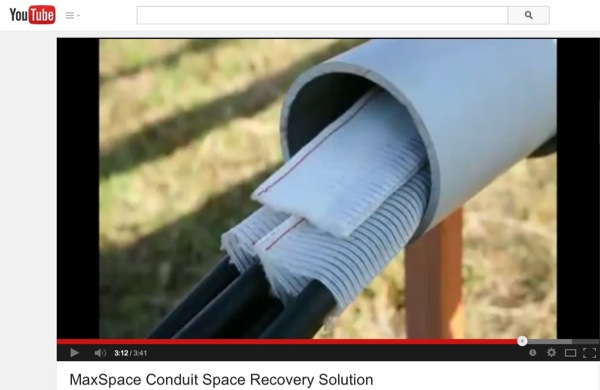
We suggest you watch the overview: http://www.youtube.com/watch?v=sf726tPAvt8&list=PLDfVYzTi8g93zg1ZYWE-bINEeADVgEMsC&index=1
Then watch some actual examples of the innerduct removal process: http://www.youtube.com/watch?v=Rs0bfd79AYM&feature=youtu.be&list=PLDfVYzTi8g93zg1ZYWE-bINEeADVgEMsC
A Really Bright Visual Fault Locator
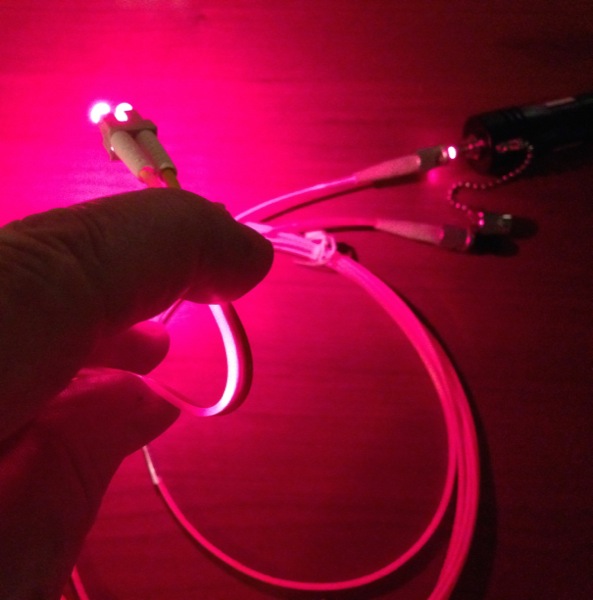
SKY Technologies recently sent us a VFL to evaluate. With a VFL, you need quite a bit of power to see splices and through some cable jackets, even MM orange (the cable in the photo) but especially other colors, so high power is an advantage. This VFL is the brightest we have seen - bright enough that you want to ensure it's aimed away from your eyes when you turn it on! It has CE and RoHS approval. Model FT650H-50B. Contact SKY for more information.
SKY Technologies Inc.
http://skytechlasers.com
http://visualfaultlocator.net
1.888.878.2374
Switch For Testing MTP/MPO Cables - Now Available for 12 or 24 fiber MPOs
Fibernext has introduced a portable switch for testing multifiber MTP/MPO connectors. You can also watch the YouTube video here.
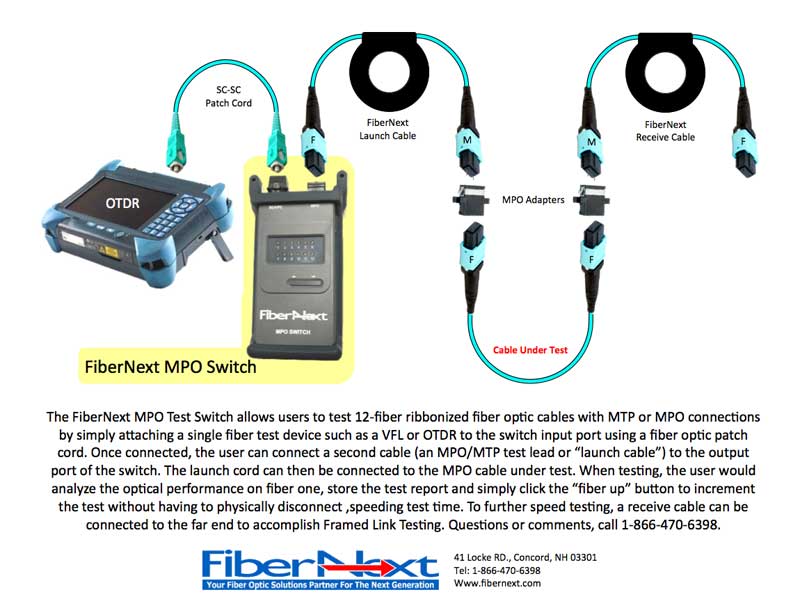
Recycling Communications Cable
FOA was contacted by a company that recycles electronics communications equipment and cabling. CommuniCom recycles cable/metals/e-waste for Telcos and CATVs. They also recycle Fiber Optic Cable and associated Materials (the fiber scrap). And, they reclaim OSP abandoned copper cables (abandoned from road moves or FTTx growth). This is a huge part of our business. They do the work (permitting/locates/labor) for free and we revenue share back with our clients (telcos).
Contact Steve Maginnis
smaginnis@communicominc.com
www.communicominc.com
803.371.5436 (cell)

Micro-Trenching, Cable Removal
Nano-Trench offers products for micro (or I guess they call it nano-) trenching and their website is very informative. They also have Kabel-X, a method of extracting copper cables from old conduit. Both websites are informative and interesting. Watch this video on the cable removal process!
Protecting Pedestals From Rodents
Pedestals and underground vaults can be damaged by rodents who come up through the base and damage cables. Uraseal "Drain N'Seal" foam deters mice from taking up residence in your pedestals. They have some good videos on using their product.
Used Test Equipment – Buy or Sell
http://www.testequipmentconnection.com/
Have you read the FOA Tech Topics on Cleaning?
As much as 70% of the problems associated with deploying fiber result from something as simple as dirty connectors according to JDSU. Telephony Online.
US Conec's videos on cleaning fibers - show's the results of proper cleaning.
Westover
- AFL
ITW Chemtronics
Cleantex Alco Pads
MicroCare
Seiko-Giken
- RETURN TO INDEX
FTTH Notes:
Many States In the US Restrict Municipal Networks
As reported in the website "Community Broadband Networks," many municipalities are creating their own networks, including FTTH like Chattanooga and Clarksville, TN, etc. But in 19 of the US states, there are laws that handicap municipalities or outright ban their offering "telecom" services. (See the list of laws compiled by Optica here.) Obviously, these laws were passed to protect the (usually monopoly) telecom and CATV providers who do not want competition. But they also make it difficult or impossible for many areas to get broadband.
Does anybody know if these laws prohibit a municipality from building a fiber network and then leasing it to an Internet service provider? Obviously, FTTH needs good lawyers too.
-
FTTH in MDUs (Multiple Dwelling Units)
When we talk about FTTH, we often assume we are installing the fiber to a “home” where it terminates in a optical line terminal (OLT) and services (voice, data and video) are delivered inside the subscriber’s "home." But since we may have detached single-family homes, row houses or living units in a large building, the situations can be quite different, requiring different architectures and installation practices. To clarify the options for fiber in MDUs, FOA has created a new page in our FTTx section of the FOA Guide to explain the options.
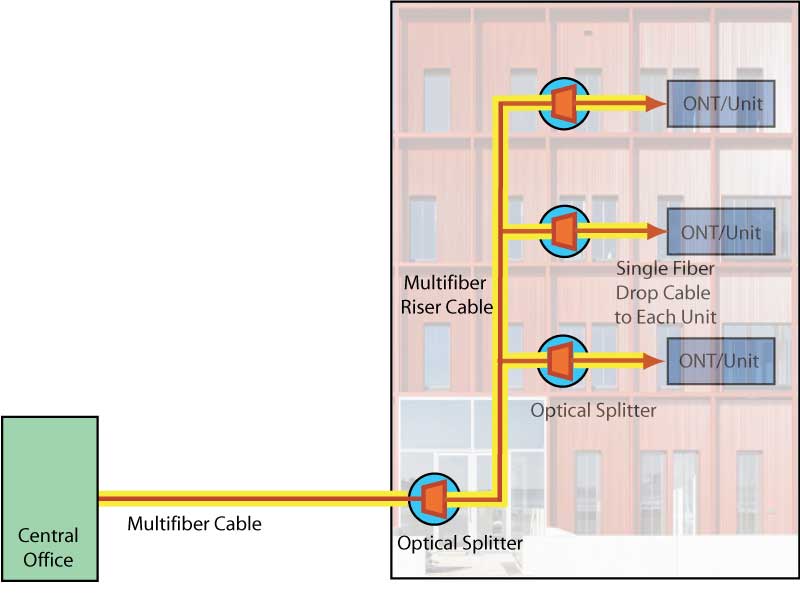
FOA Guide: FTTH in MDUs
Testing FTTH
JDSU shows how to test a PON with an OTDR: http://www.jdsu.com/other-literature/PON-OTDR_fop_an_ae.pdf
-
- Want To Learn More About FTTx?
- The FOA has created a special FTTx resources section of our website with a FTTx links page with lots of links to news, market reports, technical articles and vendor technical and product information. Here is a great place to start learning more about FTTx.
- FOA's CFxT FTTx Certification Program Explained
- Read the Broadband Properties article about the FOA FTTx certification program. Read the article about FOA President Jim Hayes being honored for his work promoting FTTH.
|




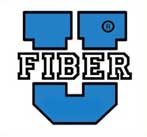

















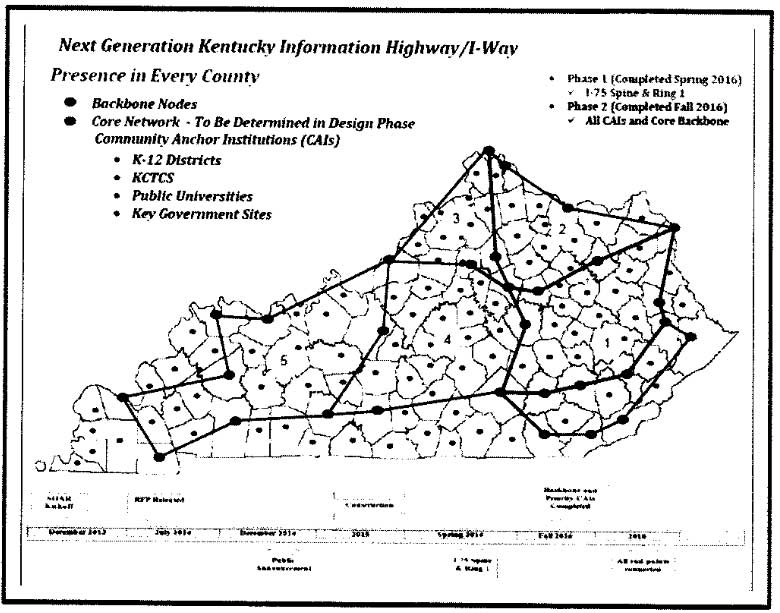
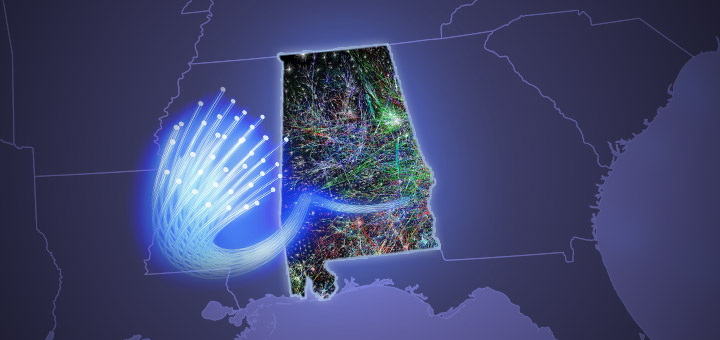




















 Corporate Memberships
Corporate Memberships





































